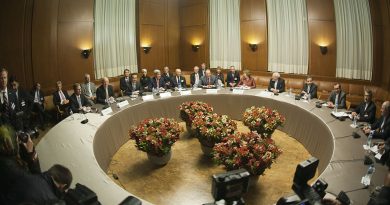UDSA Visits UN Institute for Disarmament
Neve Walker
Staff Writer
On Friday, March 1, Seton Hall University’s Undergraduate Diplomacy Student Association (UDSA) organized a trip where students of Seton Hall had the opportunity to visit the United Nations Institute for Disarmament (UNIDIR), where they attended the Cyber Stability Conference. This conference, hosted at the New York UN headquarters, had the theme of “Unpacking Cyber Threats to International Peace and Security.”
Students were able to see various professionals in the cyber security field in action, including John Reyels, Head of Cyber Policy Coordination Staff for the German Ministry of Foreign Affairs; Karl Karlovich Tikhaze, Deputy Director, Department of International Information Security of the Russian Federation; Howie Wachtel, Senior Director UN Affairs, Microsoft; Jérôme Barbier, Head of Outer Space, Digital, Economic Issues for the Paris Peace Forum; Ernst Noorman, Ambassador at Large for Cyber Affairs for the Netherlands Ministry of Foreign Affairs among many other speakers. Speakers opened the conference with opening remarks, sharing what would be discussed and its importance.
Despite the overall theme, each portion of the conference had its own topic. Session one asked how different types of malicious cyber activities are undermining national, regional, and international security. The section focused on various small-scale cyber-attacks such as ransomware, phishing and scamming. This session’s speakers underscored the dangers of the evolution of the threat landscape combined with our lack of innovation regarding combatting those threats. The speakers aimed to discuss and attain a shared understanding of the threats to cybersecurity and how those threats may impact the safety of each nation.
The second session referred to how these different types of malicious cyber activities impact the implementation of the framework of responsible state behavior, and how it can be enacted to change the ways that cyber-attacks impact nations by reducing the negative effects of cyber-attacks and decreasing their likelihood. The framework was a key aspect of this session, as it was mentioned by different speakers throughout the conversation. The framework was created by the establishment of the Wassenaar Arrangement and United Nations resolution 70/237.
Session three included a discussion on how the actors within the cyber domain have developed or changed throughout time, and what that may mean in the international attempt at mitigating cyber-threats. The speakers all provided valuable insight into not only the threat landscape and our vulnerability as actors within cyberspace, but also to the actors that are performing these attacks. The intermingled web of actors within cyberspace makes controlling and protecting what is contained in cyberspace extremely difficult, so this section of the conference acknowledged the challenges of implementing the framework to minimize cyber-threats.
The last session focused on the complexity of the threat actor landscape in the cyber domain and how it affects the implementation of responsible state behavior. This session hosted a panel of speakers who contributed to a discussion about the importance of diversifying solutions as well as evolving already-used solutions that may move us closer to a world that is cyber-secure. Furthermore, these speakers stressed the growing field of people needed to work on cyber security measures. Roberto Baldoni, a professor and former Director General at the Nation Cyber Security Agency of Italy, projected that in 10 years, 80 million positions will open regarding cyberspace.
The conference ended with a reception where Seton Hall University students were able to mingle and speak with other attendees of this conference as well as to the panelists. This invaluable opportunity allowed students to ask any question they may have regarding the cyber-security field, as well as hear the insights of the speakers one-on-one.
Image courtesy of Getty Images

